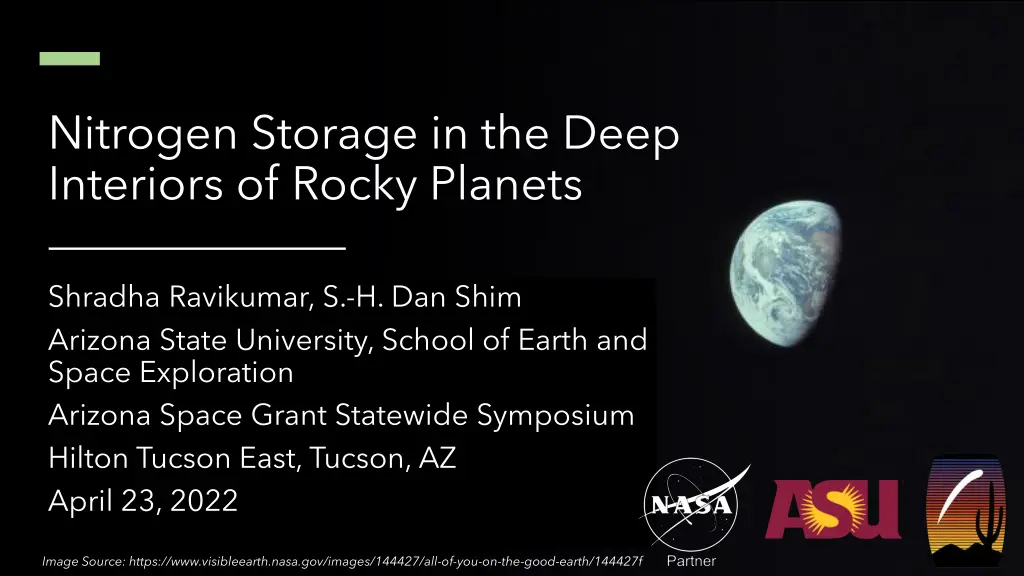
Exploring Nitrogen Storage in Rocky Planets' Deep Interiors
Discover the significance of nitrogen storage in the deep interiors of rocky planets and how it relates to Earth's missing nitrogen problem. Explore techniques like solid solution between ringwoodite and silicon nitride and the application of Density-Functional Theory (DFT) in approximating material properties. Assess the stability and future implications of these studies for Earth's atmospheric evolution and habitability on rocky exoplanets.
Download Presentation

Please find below an Image/Link to download the presentation.
The content on the website is provided AS IS for your information and personal use only. It may not be sold, licensed, or shared on other websites without obtaining consent from the author. If you encounter any issues during the download, it is possible that the publisher has removed the file from their server.
You are allowed to download the files provided on this website for personal or commercial use, subject to the condition that they are used lawfully. All files are the property of their respective owners.
The content on the website is provided AS IS for your information and personal use only. It may not be sold, licensed, or shared on other websites without obtaining consent from the author.
E N D
Presentation Transcript
Nitrogen Storage in the Deep Interiors of Rocky Planets Shradha Ravikumar, S.-H. Dan Shim Arizona State University, School of Earth and Space Exploration Arizona Space Grant Statewide Symposium Hilton Tucson East, Tucson, AZ April 23, 2022 Image Source: https://www.visibleearth.nasa.gov/images/144427/all-of-you-on-the-good-earth/144427f
Why study nitrogen storage? Source: Marty et al. 2012 Earth s missing nitrogen problem Mantle transition zone (~500 to 660 km depth)
How could N be sequestered? Source: Nagata 2005 Solid solution between ringwoodite (Mg2SiO4) and silicon nitride (Si3N4)
Density-Functional Theory (DFT) What is DFT? Approximates electronic structure and material properties of solids using quantum mechanics Software: GPAW, ASE in Python ASU Agave Supercluster Image Source: https://gitlab.com/ase/ase Image Source: https://wiki.fysik.dtu.dk/gpaw/devel/devel.html?highlight=logo
End-Member Data Internal energy (U) Volume (V) 0-25 GPa (5 GPa intervals) k-points: 8, 8, 8 Encut value: 800 XC functional: LDA Ringwoodite (Mg2SiO4) Silicon Nitride (Si3N4)
Solid Solution Data 6.25 mol% Silicon Nitride (Si3N4) 93.75 mol% Silicon Nitride (Si3N4)
Assessing Stability Change in internal energy Pressure H = U + H = U + P V P V Change in Change in enthalpy enthalpy Change in unit cell volume
Assessing Stability (XC Functional: PBE) Change in internal energy Pressure H = U + H = U + P V P V Change in Change in enthalpy enthalpy Change in unit cell volume
Significance and Future Work With varying pressure, ringwoodite/silicon nitride mixture is unstable DFT limitations High-temperature effects Experimental synthesis of solid solution ASU s multi-anvil press Implications Earth s atmospheric evolution, habitability Terrestrial planets, rocky exoplanets
Thank You! Acknowledgements I would like to thank Dr. Dan Shim for his mentorship and guidance on this project. I would also like to thank the other members of the Dan Shim Lab for their time and input, and the ASU/NASA Space Grant Program for funding this work.
Sources Marty, B. (2012). The origins and concentrations of water, carbon, nitrogen and noble gases on Earth. Earth and Planetary Science Letters, 313 314(1), 56 66. Nagata, S. (2005). Metal-Insulator Transition in the Thiospinel CuIr2S4. Chinese Journal of Physics (Taipei), 43(3S), 722-735.
